Slowed rotor
The Slowed rotor principle is used in the design of some helicopters. On a conventional helicopter the rotational speed of the rotor is constant; reducing it at lower flight speeds can also reduce fuel consumption and enable the aircraft to fly more economically. In the compound helicopter and related aircraft configurations such as the gyrodyne and winged autogyro, reducing the rotational speed of the rotor and offloading part of its lift to a fixed wing reduces the drag, enabling the aircraft to fly faster.
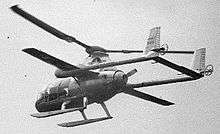
Introduction
Traditional helicopters get both their propulsion and lift from the main rotor, and by using a dedicated propulsion device such as a propeller or jet engine, the rotor burden is lessened.[1] If wings are also used to lift the aircraft, the rotor can be unloaded (partially or fully) and its rotational speed further reduced, enabling higher aircraft speed. Compound helicopters use these methods,[2][3][4] but the Boeing A160 Hummingbird shows that rotor-slowing is possible without wings or propellers, and regular helicopters may reduce turbine RPM (and thus rotor speed) to 85% using 19% less power.[5] Alternatively, research suggests that twin-engine helicopters may decrease consumption by 25%-40% when running only one engine, given adequate height and velocity well inside the safe areas of the height–velocity diagram.[6][7][8]
As of 2012, no compound or hybrid wing/rotor (manned) aircraft has been produced in quantity, and only a few have been flown as experimental aircraft,[9] mainly because the increased complexities have not been justified by military or civilian markets.[10] Varying the rotor speed may induce severe vibrations at specific resonance frequencies.[11]
Contra-rotating rotors like on Sikorsky X2 solve the problem of lift dissymmetry by having both left and right sides provide near equal lift with less flapping.[12][1] The X2 deals with the compressibility issue by reducing its rotor speed[1] from 446 to 360 RPM[13][14] to keep the advancing blade tip below the sound barrier when going above 200 knots.[15]
Design principles
Speed limits of aircraft rotors
The Rotors of conventional helicopters are designed to operate at a fixed speed of rotation, to within a few percent.[16][17][18][11] This introduces limitations in areas of the flight envelope where the optimal speed differs.[5]
In particular, it limits the maximum forward speed of the aircraft. Two main issues restrict the speed of rotorcraft:[11][4][19][12]
- Retreating blade stall. As forward speed of the helicopter increases, the airflow over the retreating blade becomes relatively slower, while the airflow over the advancing blade is relatively faster, creating more lift. If not counteracted by flapping,[20] this would cause dissymmetry of lift and eventually retreating blade stall,[2][3][21][22][1] and blade stability suffers as the blade reaches its limits for flapping.[12][23]
- Transonic drag near the rotor blade tip. The faster-moving advancing blade tip may begin to approach the speed of sound, where transonic drag begins to rise steeply, and severe buffeting and vibration effects can occur. This effect prevents any further increase in speed, even if the helicopter has surplus power remaining, and even if it features a highly streamlined fuselage. A similar effect prevents propeller-driven aircraft from achieving supersonic speeds, although they can achieve higher speeds than a helicopter, since the propeller blade isn't advancing in the direction of travel.[2][3][1][24][25][26]
These (and other)[27][28] problems limit the practical speed of a conventional helicopter to around 160–200 knots (300–370 km/h).[1][26][29][30] At the extreme, the theoretical top speed for a rotary winged aircraft is about 225 knots (259 mph; 417 km/h),[28] just above the current official speed record for a conventional helicopter held by a Westland Lynx, which flew at 400 km/h (250 mph) in 1986[31] where its blade tips were nearly Mach 1.[32]
Slowed rotors and aircraft speed
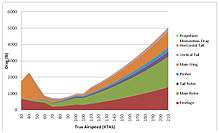
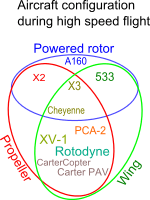
For rotorcraft, advance ratio (or Mu, symbol ) is defined as the aircraft forward speed V divided by its relative blade tip speed.[33][34][35] Upper mu limit is a critical design factor for rotorcraft,[23] and the optimum for traditional helicopters is around 0.4.[4][26]
The "relative blade tip speed" u is the tip speed relative to the aircraft (not the airspeed of the tip). Thus the formula for Advance ratio is
where Omega (Ω) is the rotor's angular velocity, and R is the rotor radius (about the length of one rotor blade)[36][23][13]
When the rotor blade is perpendicular to the aircraft and advancing, its tip airspeed Vt is the aircraft speed plus relative blade tip speed, or Vt=V+u.[12][37] At mu=1, V is equal to u and the tip airspeed is twice the aircraft speed.
At the same position on the opposite side (retreating blade), the tip airspeed is the aircraft speed minus relative blade tip speed, or Vt=V-u. At mu=1, the tip airspeed is zero.[30][38] At a mu between 0.7 and 1.0, most of the retreating side has reverse airflow.[13]
Although rotor characteristics are fundamental to rotorcraft performance,[39] little public analytical and experimental knowledge exists between advance ratios of 0.45 to 1.0,[13][40] and none is known above 1.0 for full-size rotors.[41][42] Computer simulations are not capable of adequate predictions at high mu.[43][44] The region of reverse flow on the retreating blade is not well understood,[45][46] however some research have been conducted,[47][48] particularly for scaled rotors.[49][50] The US Army Aviation Applied Technology Directorate runs a supporting program in 2016 aiming at developing transmissions with a 50% rotor speed reduction.[51]
The profile drag of a rotor corresponds to the cube of its rotational speed.[52][53] Reducing the rotational speed is therefore a significant reduction of rotor drag, allowing higher aircraft speed[13] A conventional rotor such as the UH-60A has lowest consumption around 75% rpm, but higher aircraft speed (and weight) requires higher rpm.[54]
A rotor disk with variable radius is a different way of reducing tip speed to avoid compressibility, but blade loading theory suggests that a fixed radius with varying rpm performs better than a fixed rpm with varying radius.[55]
Fuel economy of slowed rotors
Conventional helicopters have constant-speed rotors and adjust lift by varying the blade angle of attack or collective pitch. The rotors are optimised for high-lift or high-speed flight modes and in less demanding situations are not as efficient.
The profile drag of a rotor corresponds to the cube of its rotational speed.[52][53] Reducing the rotational speed and increasing the angle of attack can therefore give a significant reduction in rotor drag, allowing lower fuel consumption.[5]
History
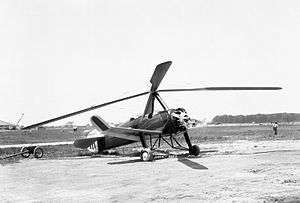
Technical parameters given for each type listed:
- maximum speed.
- μ, the ratio of forward airspeed to rotational tip speed.
- Rotor lift as a percentage of total lift, at full speed.
- Lift-to-drag ratio (L/D).
Early development
When Juan de la Cierva developed the autogyro through the 1920s and 30s, it was found that the tip speeds of the advancing rotor blade could become excessive. Designers such as he and Harold F. Pitcairn developed the idea of adding a conventional wing to offload the rotor during high-speed flight, allowing it to rotate at slower speeds.
The Pitcairn PCA-2 of 1932 had a maximum speed of 20-102 knots (117 mph; 189 km/h),[56] μ = 0.7,[57] and L/D = 4.8[58]
NACA engineer John Wheatley examined the effect of varying advance ratios up to about 0.7 in a wind tunnel in 1933 and published a landmark study in 1934. Although lift could be predicted with some accuracy, by 1939 the state of the art theory still gave unrealistically low values for rotor drag.[59]
Postwar projects
Fairey Aviation in the UK developed a series of experimental tip-jet driven gyrodynes in the late 1940s and 1950s. They culminated in the Fairey Rotodyne, a VTOL passenger aircraft with a single main rotor supplemented by wings and twin turboprop engines. In forward flight the power to the rotor was reduced to about 10%. 166 knots (191 mph; 307 km/h).[60][61] 0.6.[62] 120 to 140[63] 60% \ 40%.[64]
At the same time, the US Air Force was investigating fast VTOL aircraft. McDonnell developed what became the McDonnell XV-1, the first of the V-designated types, which flew in 1955. It was a tip-jet driven gyrodyne, which turned off rotor thrust at high airspeeds and relied on a pusher propeller to maintain forward flight and rotor autorotation. Lift was shared between the rotor and stub wings. It established a rotorcraft speed record of 170 knots (200 mph; 310 km/h). 0.95.[65] 180-410[66] (50%[67]). 85% \ 15%.[68] 6.5 (Wind tunnel tests at 180 RPM with no propeller.[69])
The Lockheed AH-56 Cheyenne arose out of Lockheed's ongoing research programme into rigid rotors, which began with the CL-475 in 1959. Stub wings and a thrust turbojet to offload the rotor were first added to an XH-51A and in 1965 this allowed the craft to achieve a world speed record of 272 miles per hour (438 km/h). The Cheyenne flew just two years later, obtaining its forward thrust from a pusher propeller. However it did not enter production.[70] 212 knots (244 mph; 393 km/h).[71][72] 0.8.[65] .. \ 20%.[73]
The Piasecki 16H Pathfinder project similarly evolved an initially conventional design into a compound helicopter through the 1960s, culminating in the 16H-1A Pathfinder II which flew successfully in 1965. Thrust was obtained via a ducted fan at the tail.[74]
The Bell 533 of 1969 was a compound jet helicopter. 275 knots (316 mph; 509 km/h).[75][76]
- Some postwar types
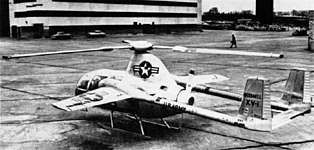 McDonnell XV-1. Optionally powered rotor, pusher propeller, wings.
McDonnell XV-1. Optionally powered rotor, pusher propeller, wings.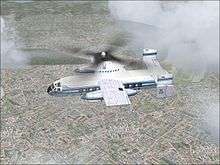 Fairey Rotodyne. Optionally powered rotor, tractor propellers, wings.
Fairey Rotodyne. Optionally powered rotor, tractor propellers, wings._4017.jpg) Lockheed AH-56 Cheyenne. Powered rotor, pusher propeller, wings.
Lockheed AH-56 Cheyenne. Powered rotor, pusher propeller, wings.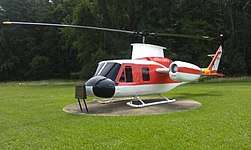 Bell 533. Powered rotor, jets, wings.
Bell 533. Powered rotor, jets, wings.
Modern developments
The compound helicopter has continued to be studied and flown experimentally. In 2010 the Sikorsky X2 flew with coaxial rotors. 250 knots (290 mph; 460 km/h).[77][78] 0.8.[13] 360 to 446.[13][14] No wings.[79] In 2013 the Eurocopter X3 flew.[80] 255 knots (293 mph; 472 km/h).[81][82] 310 minus 15%.[12] 40[12][1]-80% \.[83][84]
The compound autogyro, in which the rotor is supplemented by wings and thrust engine but is not itself powered, has also undergone further refinement by Jay Carter Jr. He flew his CarterCopter in 2005. 150 knots (170 mph; 280 km/h).[85] 1. 50%.[13] By 2013 he had developed its design into a personal air vehicle, the Carter PAV. 175 knots (201 mph; 324 km/h). 1.13. 105[86] to 350.[87]
The potential of the slowed rotor in enhancing fuel economy has also been studied in the Boeing A160 Hummingbird UAV, a conventional helicopter. 140 knots (160 mph; 260 km/h). 140 to 350.[88]
- Recent slowed rotor aircraft
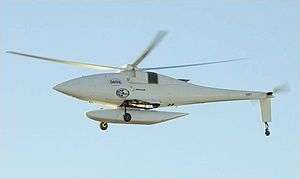 Boeing A160 Hummingbird
Boeing A160 Hummingbird
No wings, no propeller..jpg) Sikorsky X2
Sikorsky X2
Powered rotor, pusher propeller, no wings.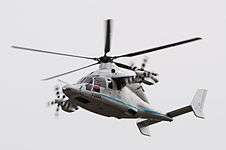 Eurocopter X3
Eurocopter X3
Powered rotor, tractor propellers, wings.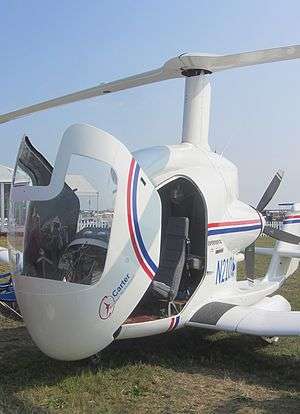 Carter PAV
Carter PAV
Unpowered rotor, pusher propeller, wings.
See also
References
Citations
- Chandler, Jay. "Advanced rotor designs break conventional helicopter speed restrictions (page 1) Archived 2013-07-18 at the Wayback Machine" Page 2 Archived 2013-07-18 at the Wayback Machine Page 3 Archived 2013-07-18 at the Wayback Machine. ProPilotMag, September 2012. Accessed: 10 May 2014. Archive 1 Archive 2 Archive 3
- Robb 2006, page 31
- Silva 2010, page 1.
- Harris 2003, page 7
- Khoshlahjeh
- Dubois, Thierry. "Researchers Look at Single-engine Cruise Ops on Twins" AINonline, 14 February 2015. Accessed: 19 February 2015.
- Perry, Dominic. "Airbus Helicopters promises safe single-engine operations with Bluecopter demonstrator" Flight Global, 8 July 2015. Archive
- Perry, Dominic. "Turbomeca eyes flight tests of 'engine sleep mode'" Flight Global, 25 September 2015. Archive
- Rigsby, page 3
- Johnson HT, p. 325
- Lombardi, Frank. "Optimizing the Rotor" Rotor&Wing, June 2014. Accessed: 15 June 2014. Archived on 15 June 2014
- Nelms, Douglas. "Aviation Week Flies Eurocopter’s X3" Aviation Week & Space Technology, 9 July 2012. Accessed: 10 May 2014. Alternate link Archived on 12 May 2014
- Datta, page 2.
- Jackson, Dave. "Coaxial - Sikorsky ~ X2 TD" Unicopter. Accessed: April 2014.
- Walsh 2011, page 3
- Robert Beckhusen. "Army Dumps All-Seeing Chopper Drone" Wired June 25, 2012. Accessed: 12 October 2013. "for standard choppers ... the number of revolutions per minute is also set at a fixed rate"
- The UH-60 permits 95–101% rotor RPM UH-60 limits US Army Aviation. Retrieved 2 January 2010
- Trimble, Stephen (3 July 2008). "DARPA's Hummingbird unmanned helicopter comes of age". FlightGlobal. Archived from the original on 14 May 2014. Retrieved 14 May 2014.
The rotor speed on a typical helicopter can be varied around 95-102%
- Chiles, James R. "Hot-Rod Helicopters" Page 2 Page 3 Air & Space/Smithsonian, September 2009. Accessed: 18 May 2014.
- "Blade flapping" Dynamic Flight
- "Helicopter Limitations" Challis Heliplane
- "Retreating blade stall" Dynamic Flight
- Johnson HT, p. 323
- Prouty, Ray. "Ask Ray Prouty: Compound Helicopters, Compressibility (archived)" Rotor&Wing, 1 May 2005. Accessed: 11 Dec 2019.
- "Nomenclature: Transonic drag rise" NASA
- Filippone, Antonio (2000). "Data and performances of selected aircraft and rotorcraft" pages 643-646. Department of Energy Engineering, Technical University of Denmark / Progress in Aerospace Sciences, Volume 36, Issue 8. Accessed: 21 May 2014. doi:10.1016/S0376-0421(00)00011-7 Abstract
- Beare, Glenn. "Why can't a Helicopter fly faster than it does ?" helis.com . Accessed: 9 May 2014.
- Krasner, Helen. "Why Can’t Helicopters Fly Fast?" Decoded Science, 10 December 2012. Accessed: 9 May 2014.
- Majumdar, Dave. "DARPA Awards Contracts in Search of a 460 MPH Helicopter" United States Naval Institute, 19 March 2014. Accessed: 9 May 2014.
- Wise, Jeff. "The Rise of Radical New Rotorcraft" Popular Mechanics, 3 June 2014. Accessed: 19 June 2014. Archive Quote: "This aerodynamic principle limits conventional helicopters to about 200 mph."
- "Rotorcraft Absolute: Speed over a straight 15/25 km course Archived 2013-12-03 at the Wayback Machine". Fédération Aéronautique Internationale (FAI). Note search under E-1 Helicopters and "Speed over a straight 15/25 km course". Accessed: 26 April 2014.
- Hopkins, Harry (27 December 1986), "Fastest blades in the world" (pdf), Flight International: 24–27, retrieved 28 April 2014,
Archive page 24 Archive page 25 Archive page 26 Archive page 27
- "Nomenclature: Mu" NASA
- Definition of Advance ratio
- "Flapping Hinges" Aerospaceweb.org. Accessed: 8 May 2014.
- Jackson, Dave. "Tip Speed Ratio (Advance Ratio)" Unicopter, 6 September 2013. Retrieved: 22 May 2015. Archived on 21 October 2014.
- "Helicopter Flying Handbook", Chapter 02: Aerodynamics of Flight (PDF, 9.01 MB), Figure 2-33 page 2-18. FAA-H-8083-21A, 2012. Accessed: 21 May 2014.
- Berry, page 3-4
- Harris 2008, page 13
- Berry, page 25
- Harris 2008, page 25
- Kottapalli, page 1
- Harris 2008, page 8
- Bowen-Davies, page 189-190
- Harris 2008, page 14
- Bowen-Davies, page 198
- DuBois 2013
- Potsdam, Mark; Datta, Anubhav; Jayaraman, Buvana (18 March 2016). "Computational Investigation and Fundamental Understanding of a Slowed UH-60A Rotor at High Advance Ratios". Journal of the American Helicopter Society. 61 (2): 1–17. doi:10.4050/JAHS.61.022002.
- Bowen-Davies, page 216
- Granlund, Kenneth; Ol, Michael; Jones, Anya (2016). "Streamwise oscillation of airfoils into reverse-flow". AIAA Journal. 54 (5): 1628–1636. Bibcode:2016AIAAJ..54.1628G. doi:10.2514/1.J054674.
- Renata Y. Ellington & Laurie Pierce (21 March 2016). "Contract Activity: Next Generation Rotorcraft Transmission (NGRT)". Aviation Applied Technology Directorate. GovTribe. Archived from the original on 27 March 2016. Retrieved 27 March 2016.
- Gustafson, page 12
- Johnson RA, page 251.
- Bowen-Davies, page 97-99
- Bowen-Davies, page 101
- Harris 2003, page A-40
- Harris 2008, page 19
- Duda, Holger; Insa Pruter (2012). "Flight performance of lightweight gyroplanes" (PDF). German Aerospace Center. p. 5. Retrieved 5 April 2020.
- Harris (2008) pp.35-40.
- "FAI Record ID #13216 - Rotodyne, Speed over a closed circuit of 100 km without payload Archived 2015-02-17 at the Wayback Machine" Fédération Aéronautique Internationale. Record date 5 January 1959. Accessed: April 2014.
- Anders, Frank. (1988) "The Fairey Rotodyne" (excerpt) Gyrodyne Technology (Groen Brothers Aviation). Retrieved: 17 January 2011. Archived 26 February 2014
- Rigsby, page 4
- "Requiem for the Rotodyne." Flight International, 9 August 1962, pp. 200–202.
- Braas, Nico. "Fairey Rotodyne" Let Let Let Warplanes, 15 June 2008. Accessed: April 2014. Archived on 30 September 2013
- Anderson, Rod. "The CarterCopter and its legacy" Issue 83, Contact Magazine, 30 March 2006. Accessed: 11 December 2010. Mirror
- Harris 2003, page 14
- Watkinson, page 355
- Robb 2006, page 41
- Harris 2003, page 18. Lift forces at page A-101
- Munson 1973. pp.55,144-5.
- Landis and Jenkins 2000, pp. 41–48.
- "AH-56A Cheyenne" Globalsecurity.org. Accessed: April 2014.
- Harris? not 2008, not Vol1+2, page 119
- Munson 1973. pp.96,187-8.
- Robb 2006, page 43
- Spenser, Jay P. "Bell Helicopter". Whirlybirds, A History of the U.S. Helicopter Pioneers, p. 274. University of Washington Press, 1998. ISBN 0-295-98058-3.
- Croft, John (15 September 2010). "Sikorsky X2 hits 250kt goal". Flight International. Archived from the original on 17 January 2011. Retrieved 15 September 2010.
- Goodier, Rob (September 20, 2010). "Inside Sikorsky's Speed-Record-Breaking Helicopter Technology". Popular Mechanics. Retrieved 22 September 2010.
- D. Walsh, S. Weiner, K. Arifian, T. Lawrence, M. Wilson, T. Millott and R. Blackwell. "High Airspeed Testing of the Sikorsky X2 Technology Demonstrator" Sikorsky, May 4, 2011. Accessed: October 5, 2013.
- The X3 concept Archived 2014-05-12 at the Wayback Machine Video1 Video2, at 2m50s Airbus Helicopters. Accessed: 9 May 2014.
- Thivent, Viviane. "Le X3, un hélico à 472 km/h" Le Monde, 11 June 2013. Accessed: 10 May 2014. Possible mirror
- X3 Helicopter Sets Speed Record At Nearly 300 MPH Wired
- Norris, Guy. "Eurocopter X-3 Targets U.S. Market" Aviation Week, 28 February 2012. Accessed: 1 March 2012. Mirror
- Tarantola, Andrew. "Monster Machines: The New Fastest Helicopter On Earth Can Fly At An Insane 480km/h" Gizmodo, 19 June 2013. Accessed: April 2014.
- Wise, Jeff. "Jay Carter, Jr." Popular Science, 2005. Magazine
- Warwick, Graham. "Carter Hopes To Demo SR/C Rotorcraft To Military" Aviation Week, 5 February 2014. Accessed: 19 May 2014. Archived on 19 May 2014
- Moore, Jim. "Carter seeks factory" Aircraft Owners and Pilots Association, 21 May 2015. Accessed: 28 May 2014. Archived on 22 May 2015.
- Hambling, David. "The Rise of the Drone Helicopter - A160T Hummingbird" Popular Mechanics. Accessed: April 2014.
Bibliography
- Berry, Ben & Chopra, Inderjit. Slowed Rotor Wind Tunnel Testing at UMD University of Maryland, 19 February 2014. Size: 3MB. Archive
- Bowen-Davies, Graham M. Performance and loads of variable tip speed rotorcraft at high advance ratios (dissertation) University of Maryland, 25 June 2015. Header. DOI:10.13016/M2N62C . Size: 313 pages in 7MB
- Datta, Anubhav et al. (2011). Experimental Investigation and Fundamental Understanding of a Slowed UH-60A Rotor at High Advance Ratios NASA ARC-E-DAA-TN3233, 2011. Header Accessed: April 2014. Size: 26 pages in 2MB
- DuBois, Cameron J. (2013). Flow Control on an Airfoil Under Reversed Flow Conditions Using Nanosecond Dielectric Barrier Discharge Actuators (dissertation abstract) Ohio State University. Accessed: 4 December 2014. Size: 86 pages in 6MB
- Floros, Matthew W. & Wayne Johnson (2004). Stability Analysis of the Slowed-Rotor Compound Helicopter Configuration (1MB). Defense Technical Information Center, 2004. Alternate version, 8MB
- Gustafson, F. B. Effect on helicopter performance of modifications in profile-drag characteristics of rotor-blade airfoil sections NACA, August 1944.
- Harris, Franklin D. (2003). An Overview of Autogyros and the McDonnell XV–1 Convertiplane NASA/CR—2003–212799, 2003. Header Mirror1, Mirror2. Size: 284 pages in 13MB
- Harris, Franklin D. (2008). Rotor Performance at High Advance Ratio: Theory versus Test NASA/CR—2008–215370, October 2008. Header Mirror. Accessed: 13 April 2014. Size: 521 pages in 5MB
- Johnson, Wayne (2012). Helicopter Theory. Courier Corporation. p. 323. ISBN 978-0-486-13182-5.
- Johnson, Wayne (2013). Rotorcraft Aeromechanics. Cambridge University Press. ISBN 978-1-107-02807-4.
- Khoshlahjeh, Maryam & Gandhi, Farhan (2013). Helicopter Rotor Performance Improvement with RPM Variation and Chord Extension Morphing American Helicopter Society. Accessed: 9 June 2014.
- Kottapalli, Sesi et al. (2012). Performance and loads correlation of a UH-60A slowed rotor at high advance ratios NASA ARC-E-DAA-TN4610, June 2012. Header Size: 30 pages in 2MB
- Landis, Tony and Jenkins, Dennis R. Lockheed AH-56A Cheyenne – WarbirdTech Volume 27, Specialty Press, 2000. ISBN 1-58007-027-2.
- Munson, Kenneth (1973); Helicopters: And Other Rotorcraft Since 1907, London, Blandford, Revised edition 1973.
- Rigsby, James Michael (2008). Stability and control issues associated with lightly loaded rotors autorotating in high advance ratio flight (dissertation abstract) Georgia Institute of Technology, December 2008. Size: 166 pages in 3MB
- Robb, Raymond L. (2006). Hybrid helicopters: Compounding the quest for speed, Vertiflite. Summer 2006. American Helicopter Society. Size: 25 pages in 2MB
- Seddon, John M. (& Simon Newman). Basic Helicopter Aerodynamics John Wiley and Sons, 2011. ISBN 1-119-99410-1
- Silva, Christopher ; Yeo, Hyeonsoo ; Johnson, Wayne. (2010) Design of a Slowed-Rotor Compound Helicopter for Future Joint Service Missions NASA ADA529322. Mirror Size: 17 pages in 4MB
- D. Walsh, S. Weiner, K. Arifian, T. Lawrence, M. Wilson, T. Millott and R. Blackwell. High Airspeed Testing of the Sikorsky X2 Technology Demonstrator Sikorsky, May 4, 2011. Accessed: October 5, 2013. Size: 12 pages in 3MB
- Watkinson, John (2004). The Art of the Helicopter. Elsevier Butterworth-Heinemann. ISBN 07506-5715-4.
External links
| External image | |
|---|---|